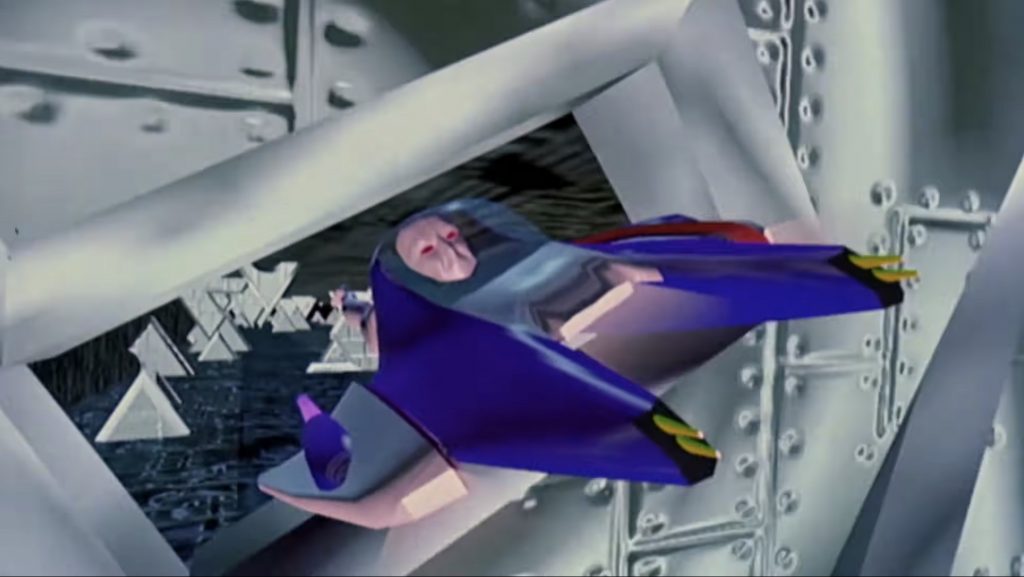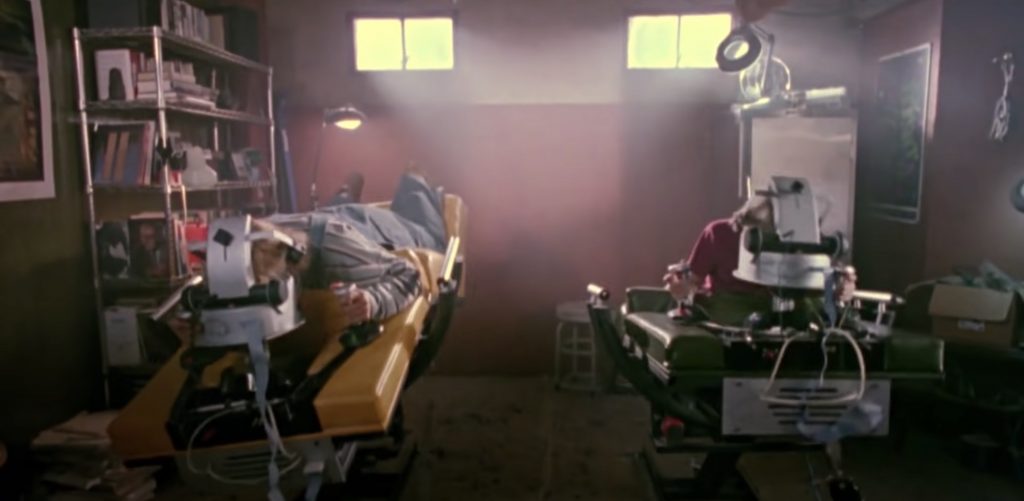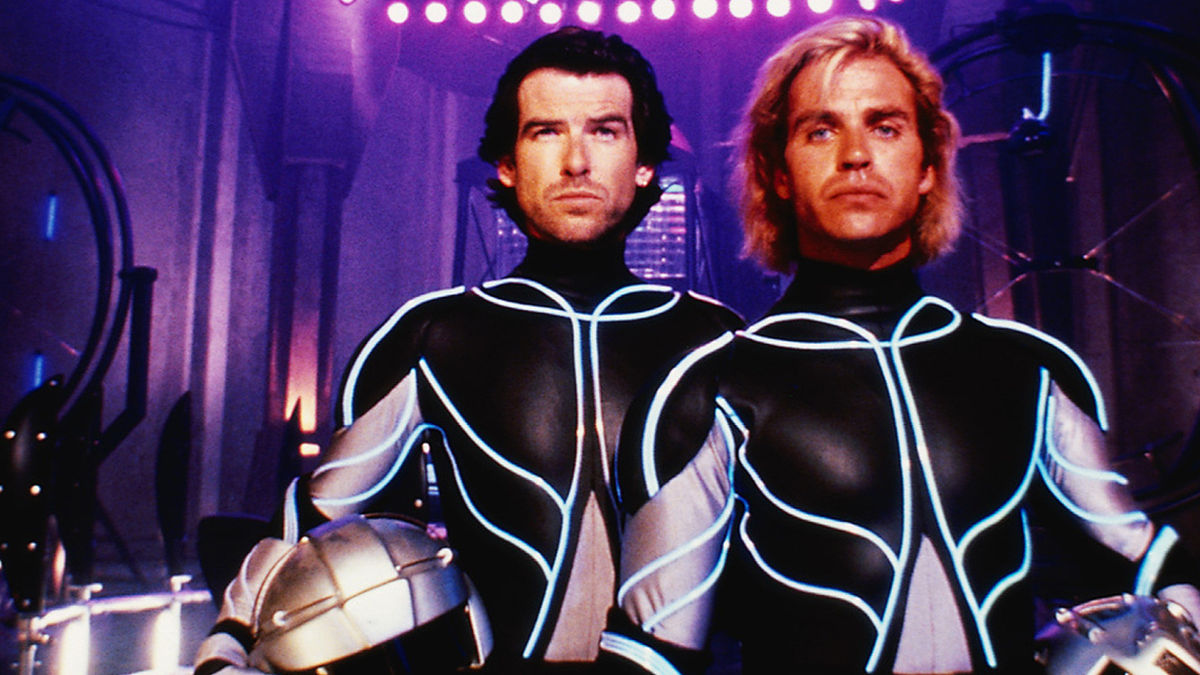Core Data:
- Vision: Virtual reality-enhanced IQ
- Type: Film
- As Seen In: The Lawnmower Man
- Envisioned: 1992
- Visionary: Brett Leonard (writer/director)
- Target Date: 1999-2000 (aka the turn of the millennium)
Overview:
Before he wore James Bond’s tuxedo for the first time, Pierce Brosnan got busy exploring cyberspace in virtual reality thriller The Lawnmower Man.
In the movie, the future 007 plays maverick scientist Dr Lawrence Angelo – we know he’s in a maverick because he doesn’t shave, wears an earring and has a grungy wardrobe. The genius innovator works for a shady tech firm, doing pioneering work with VR tech to turn chimpanzees into soldiers. But after one of the chimps goes dangerously rogue, the scientist turns his attentions to Jobe (Jeff Fahey), a kindly gardener with a learning disability.

Using a mix of sophisticated VR, ’90s computer graphics and seemingly magical drugs (don’t ask too many questions about those…), Angelo gradually transforms his test subject into a genius. This being Hollywood, however, there are inevitable side effects, and Jobe ultimately turns into something of a psychopath.
Writer/director Brett Leonard would later return to the digital realm with the less accomplished Virtuosity, while The Lawnmower Man would spawn a lesser sequel and a pair of videogames. Nonetheless, the original remains one of cinema’s most famous dalliances with VR – but how does its science live up to reality?

Key Tenets:
- Hardware: According to the opening titles, VIRTUAL REALITY – such a big deal it had to be written in CAPS – was widespread by the turn of the millennium.
- Users connect to simulations using stereoscopic headsets capable of generating three-dimensional video.
- Home VR kits allow users to control games via handheld joysticks. Players can also enhance the experience by lying on a moving bed which recreates movements within a game.
- Military-grade rigs are significantly more sophisticated – and not just because users have to wear Tron-style cyber-suits. That said, these figure-hugging outfits are capable of translating body movements directly to your VR avatar, while providing haptic feedback to the user. Nobody ever explains the purpose of the neon piping, though – that’s presumably just a bold fashion choice.
- In order to maximise sensory experience within simulations, users are suspended by wires inside large gyroscopes. Motion sickness medication should probably come as standard.
- On these advanced VR units, the standard stereoscopic headset is just the tip of the iceberg when it comes to interfacing with the software. Squirm-inducing injections into the brainstem allow the hardware to sync up with the user’s nervous and endocrine systems. Ouch…
- The VR technology can also be used in portable headsets (designed to fit a chimpanzee), creating a sophisticated heads-up display for military applications – in other words, it turns war into a videogame.
- Vast quantities of information are available at the mere click of a button – though it’s stored on CD-ROMs rather than the cloud.
- Experience: If you can get past the fact that the graphics are only slightly more realistic than the people in Dire Straits’ ‘Money for Nothing’ video, the main limitation on the VR system is the breadth of your imagination. The system does, however, exhibit a prevalence for spinny kaleidoscopic effects that make you feel like you’ve walked into an early-’90s rave promo.
- The cyberspace realm is frequently described as a new planet or universe waiting to be explored. Being one of the gatekeepers subsequently brings you great power – and presumably great responsibility as well.
- Sex programs are also available, though their tendency to turn couples into giant CG dragonflies – not to mention the risk of your partner’s brain being fried – mean they’re probably not to everyone’s tastes.
- There’s more to this technology than leisure and entertainment, however. When used in conjunction with a series of proprietary drugs, it can also be used to enhance the IQ of a human user.
- When gardener Jobe Smith hooks up to the system, his intelligence increases at an exponential rate. He can absorb information at frightening speed, gaining the ability to learn an entire language in a matter of hours – Duolingo may need to rethink its business model…
- As an unexpected side-effect, he also develops a compulsion to show off his abs and pecs while mowing people’s lawns.
- Long-term use of the equipment can awaken latent parts of the brain, giving the user telepathic and telekinetic abilities.
- Hardcore users may also find they develop a god complex and proclaim themselves the “Cyber Christ”. When this happens, there’s a chance they’ll decide to seek bloody vengeance on everyone who’s ever wronged them, before uploading their consciousness to the digital realm, in a bid to take over the world – or at least get every telephone on the planet ringing in unison.
- When wannabe digital deities cross over, they leave behind a desiccated husk of a physical body.
- Luckily, the laboratory computers in the movie aren’t connected to the internet, meaning that plans for world domination may have to be kept on hold indefinitely…
- Company:VSI, aka Virtual Space Industries, are taking VR technology to the next level.
- Funding comes from ‘The Shop’, a shadowy organisation with military connections. They’re represented by Walter White’s brother-in-law from Breaking Bad.
- Economics: Investment is less motivated by entertainment and the betterment of mankind than a desire to create super-sophisticated weapons.
- IP: The hardware can seemingly support any software you can imagine, though it remains unclear whether the headsets support Netflix.

State of Play (April 2022)
- Hardware: Give or take a few minor cosmetic tweaks, modern VR headsets (such as the Oculus Quest) look remarkably similar to the devices in The Lawnmower Man. The handheld, joystick-like controllers also exist on the same branch of the digital evolutionary tree.
- Luckily, we don’t have to slip on figure-hugging Lycra suits to plug in, but haptic gloves are capable of simulating physical sensations. “4D” movie screenings can also enhance what’s happening on screen by using moving chairs – much like the VR beds in the movie.
- Motion/performance capture also makes it possible to accurately map a person’s movements into a computer – the technology used in film, TV and videogame production is now sophisticated enough to generate a convincing recreation of the human face.
- The movie’s use of touchscreen technology is also remarkably prescient – even if the CRT screens are rather impractical compared to the sleek tablets we use today.
- Experience: While The Lawnmower Man’s use of CD-ROMs and standalone computers date it somewhat, its prediction of a digital realm where anything is possible is spot on. The movie effectively wrote the blueprint for the metaverse that’s become a highly competitive holy grail in tech circles.
- The interactive user interface featured in the VR simulations is also remarkably prescient, taking advantage of a swipe/gesture-based system more than a decade before the iPhone came on the scene.
- It may sound implausible but research suggests that VR could make you smarter. Fast Company reported in July 2021 that University of California scientists are using virtual reality simulations to increase theta rhythm activity in mice. These theta rhythms are associated with learning, cognition and memory – abnormal theta activities can lead to conditions such as Alzheimer’s, ADHD and epilepsy.
- Telepathy and telekinesis, however, remain purely in the domain of sci-fi, magicians and fraudsters.
- As is the case with Tron, transferring a human’s entire consciousness into a computer remains implausible – not least because of the compatibility issues associated with converting the complex processes that take place in the brain into computer code.
- It’s also unclear why Jobe’s body deflates when he uploads his mind to the mainframe. If that missing mass is being converted into energy, Einstein’s famous E=mc2 equation suggests that the results could be… explosive.
- If a human did cross over into the digital realm, their aspirations would surely stretch beyond making every phone on the planet ring – not least because the landline is rapidly becoming a relic of the past.
- Economics: Both VR and the metaverse are major frontiers in technology, with most of the major players in the tech space looking for a piece of the virtual pie.

Reality check: a decent prediction of VR tech and the metaverse – just ignore the cyber-god stuff
Early ’90s computer graphics aside, The Lawnmower Man’s predictions of virtual reality tech and a metaverse of opportunity are remarkably prescient. But a kindly gardener evolving into a super-intelligent, self-proclaimed digital messiah with designs on world domination? Not so much… at least for now…
Further reference:
A self-confessed full-time geek, freelance journalist Richard has spent most of his career writing about sci-fi and fantasy – including more than a decade on staff for SFX magazine. He's particularly keen on franchises with "Star" in the title.



































